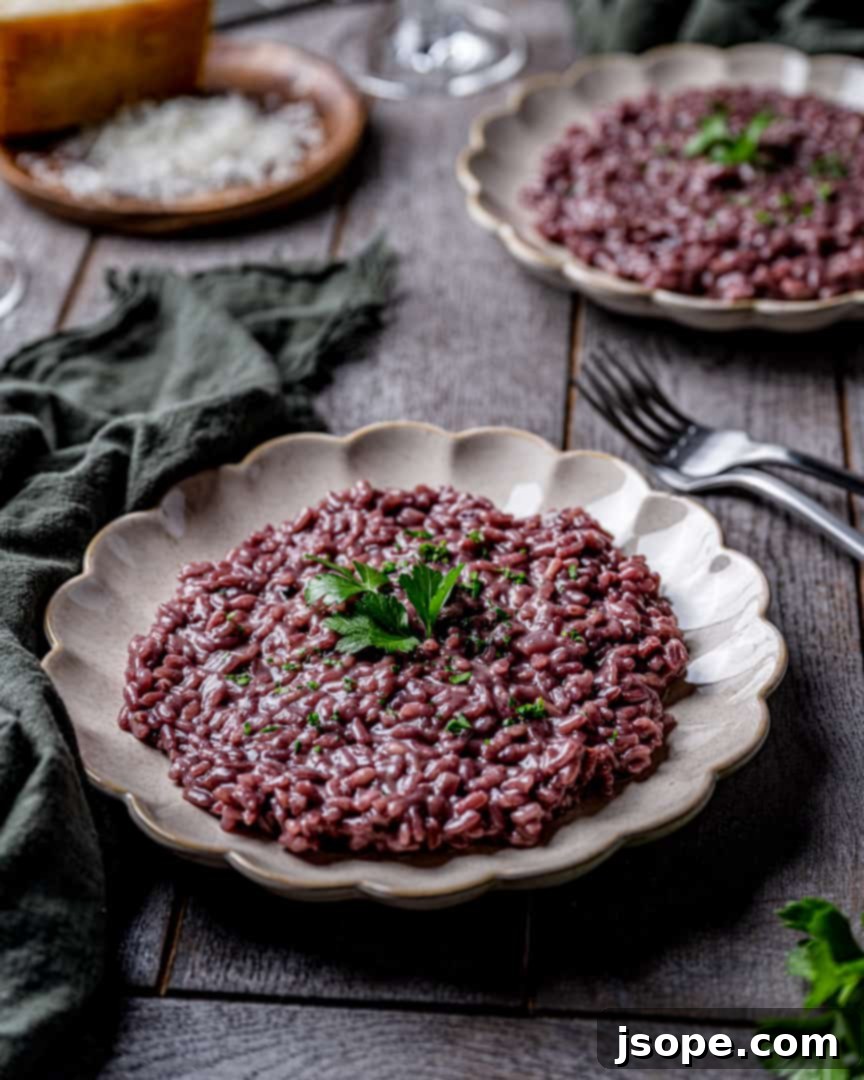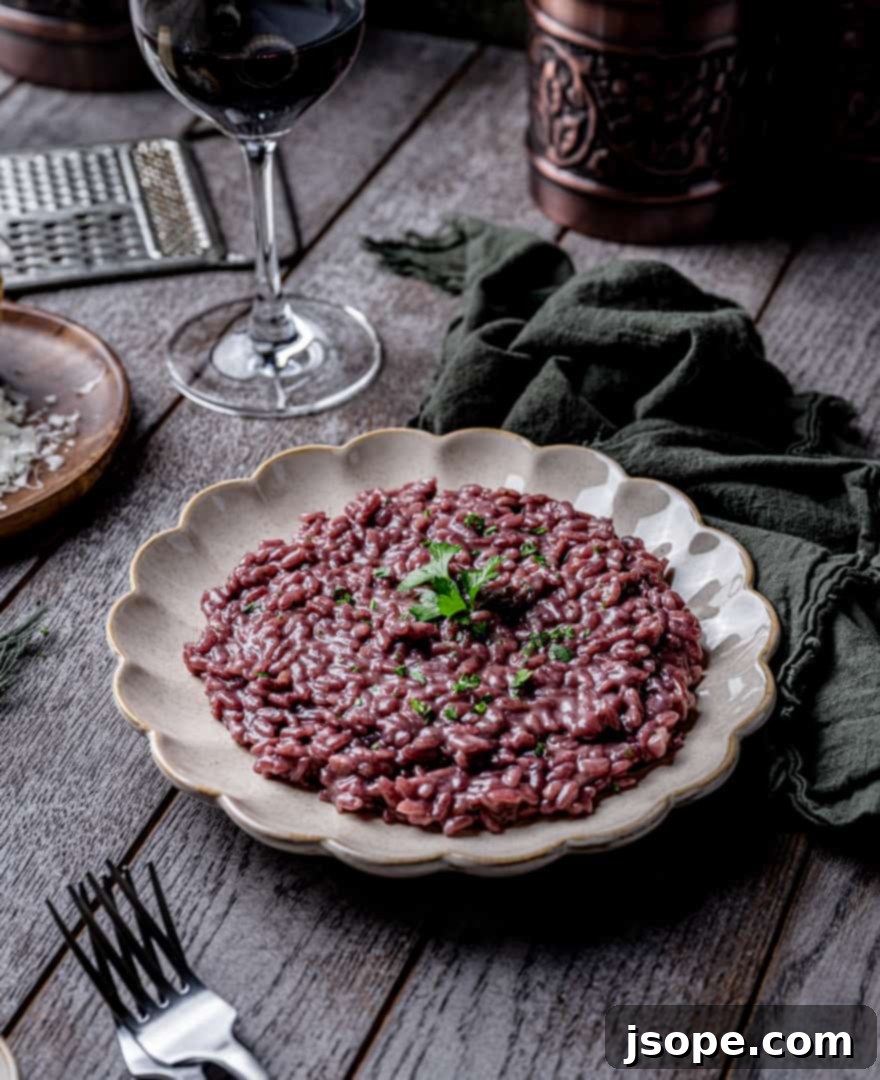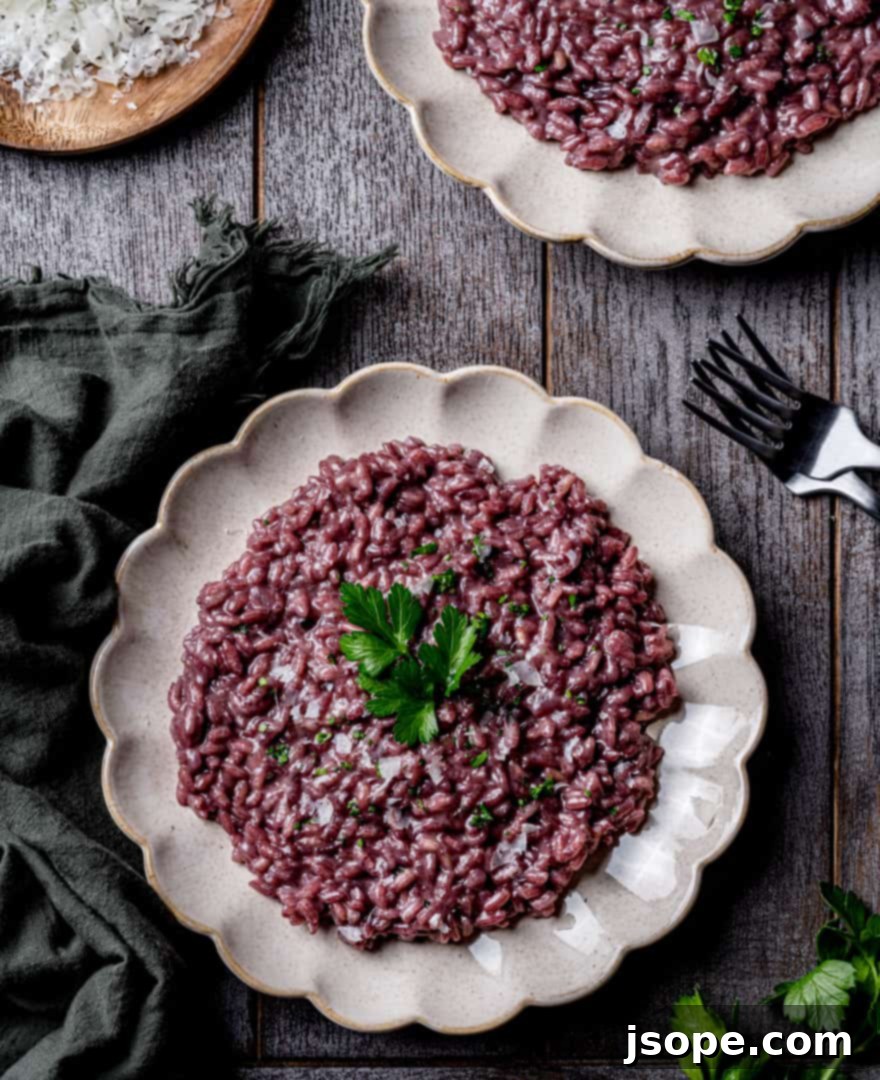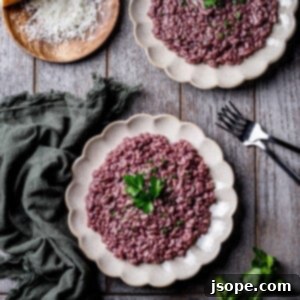There’s a special kind of comfort found in a perfectly made risotto – a dish that invites you into the kitchen for an engaging culinary experience. This Red Wine Parmesan Risotto recipe is our approachable take on Verona, Italy’s iconic Amarone risotto, reimagined for the home cook. While we’ve made some adaptations, such as using readily available rice and cheese, the spirit of the classic remains. The result is a stunning, deeply flavored, and beautifully purple-hued risotto that’s incredibly satisfying. It’s rich, luxurious, and versatile enough to be enjoyed on its own as a vegetarian main course or as a sophisticated side alongside your favorite protein. Prepare to impress your palate with this delightful twist on a beloved Italian staple.

Choosing the Best Rice for Your Risotto
The foundation of any exceptional risotto lies unequivocally in the type of rice you choose. This isn’t just a minor detail; it’s the element that can truly elevate or undermine your entire dish. It’s crucial to understand that not all rice varieties are created equal, and for risotto, you need specific short to medium-grain rices known for their high starch content and ability to absorb liquid without becoming mushy.
Our top recommendation for a truly authentic and creamy risotto is Carnaroli rice. Often dubbed the “King of Rices,” Carnaroli boasts a high amylose content, which allows it to maintain its structure while releasing a creamy starch, resulting in a perfectly al dente texture with a luxurious consistency. It’s less prone to overcooking and delivers an unparalleled mouthfeel.
Another excellent choice, especially for the classic Amarone risotto in Italy, is Vialone Nano rice. This medium-grain variety is smaller than Carnaroli and Arborio, making it cook faster and absorb liquids more evenly. It creates a very creamy risotto while still maintaining a pleasant bite. While it might be a bit harder to find in conventional American grocery stores, it is readily available online and worth seeking out for its superior qualities.
For those looking for a more accessible option, Arborio rice is widely available in most supermarkets across the United States. While it performs admirably and can certainly produce a delicious risotto, it tends to release its starch more quickly and can become softer sooner than Carnaroli or Vialone Nano. However, with careful attention during cooking, Arborio can still yield a wonderfully creamy and satisfying dish. Regardless of your choice, ensure you’re selecting a rice specifically labeled for risotto to guarantee the best possible outcome for your culinary masterpiece.
Is Making Risotto Truly Difficult? Debunking the Myth

The idea that making a creamy, perfect risotto is an insurmountable culinary challenge is a common misconception that often deters home cooks. In reality, while risotto does require a different technique than cooking other rice varieties, it is far from difficult. It’s more “hands-on” than, say, steaming plain rice, but this engagement is precisely what makes the process so rewarding and, dare we say, cathartic!
The magic of risotto unfolds as you gradually add liquid to the rice, stirring consistently. This gentle agitation coaxes the starches out of the rice grains, creating that signature creamy texture without the need for any added cream. Watching the dish transform from simple grains to a luscious, velvety concoction is incredibly satisfying.
Even if you have minimal cooking experience, you can absolutely master risotto. The key is patience and presence. Think of it as a mindful cooking practice rather than a strenuous task. It doesn’t demand advanced skills, just a bit of consistent “babysitting” at the stove. By following a few simple guidelines, anyone can achieve a restaurant-quality risotto right in their own kitchen, proving that this Italian classic is much more approachable than its reputation suggests.
Selecting the Perfect Stock: A Flavor Foundation
The stock you incorporate into your risotto is another critical component that contributes significantly to its overall flavor profile and depth. While traditional Amarone risotto often calls for beef stock, our recipe allows for flexibility to suit various preferences and dietary considerations.
We personally favor a good quality vegetable stock for this Red Wine Parmesan Risotto. Using a neutral-colored stock ensures that the beautiful deep purple hue from the red wine truly shines through, making the dish visually stunning. Furthermore, vegetable stock can make the final risotto feel a bit lighter and less heavy, allowing the nuances of the wine and Parmesan to come forward more distinctly.
However, your choice of stock is entirely adaptable. If you prefer a richer, more savory base, chicken stock is an excellent alternative that adds a subtle poultry depth without overpowering the other ingredients. For those who appreciate the traditional richness, beef stock or even veal stock can be used to impart a deeper, more robust umami flavor. When choosing, consider the balance you desire: a lighter stock for a brighter, wine-forward profile, or a heavier stock for a more profound, savory experience. Regardless of your selection, ensure your stock is warmed before adding it to the rice, as this helps maintain a consistent cooking temperature and promotes even absorption.
The Subtle Art of Flavor Makers: Caramelized Onions
Beyond the primary components, the subtle contributions of other ingredients profoundly shape the final flavor of your risotto. In this Red Wine Parmesan Risotto, the humble onion plays a crucial, albeit understated, role as a foundational flavor maker. The technique of slightly caramelizing the onion isn’t just about cooking it until soft; it’s about developing layers of sweetness and umami that will infuse the entire dish.
When onions are gently sautéed until they begin to brown, their natural sugars caramelize. This process creates a complex sweetness and depth that can’t be achieved with raw or merely translucent onions. This subtle caramelization adds a richness that complements the bold notes of the red wine and the savory depth of the Parmesan. Because of the dark, vibrant color that the red wine imparts to this risotto, the slight browning of the onions won’t adversely affect the final appearance, ensuring the dish remains visually appealing while delivering exceptional taste. This foundational step is essential for building a truly well-rounded and deeply flavorful risotto.
Selecting the Ideal Red Wine: A Culinary and Oenological Journey

The choice of red wine is paramount to the success of this risotto, acting as a co-star to the rice itself. While Amarone della Valpolicella is the traditional and revered wine for this dish in its native Verona, its availability and often prohibitive cost in North America and beyond make it less practical for everyday cooking. Fortunately, excellent substitutes abound that can deliver a similarly rich and robust flavor profile.
When selecting a red wine, it’s critical to understand how its characteristics will intensify during the cooking process. As the wine reduces, its flavors concentrate, meaning any undesirable traits will also become more pronounced. Therefore, opt for a wine that is dry, rich, and fruit-forward, but crucially, not overly tannic or acidic.
High tannins, which impart a sense of astringency or bitterness, will become harsh and unpleasant when concentrated. Similarly, an overly acidic wine will reduce to create an unpleasantly sour risotto. Avoid heavily barrel-aged wines, as their complex oak flavors can also become overwhelming and detract from the dish’s balance. Instead, seek out younger, inky red wines that offer vibrant fruit flavors and a smoother finish.
Excellent domestic substitutes that shine in this dish include Cabernet Sauvignon from California’s Central Coast and Zinfandels from Sonoma County. Both varietals typically offer the dry, rich fruit characteristics needed, often with more approachable tannin and acidity levels than some bolder, more structured reds. Other suitable options might include a good quality Merlot or a fuller-bodied Pinot Noir, depending on their specific profiles.
A golden rule for cooking with wine is to always use a wine you would genuinely enjoy drinking. This ensures that the flavors introduced to your risotto are ones you appreciate. Plus, a happy bonus: you’ll have the perfect accompaniment to sip alongside your freshly prepared Red Wine Parmesan Risotto, enhancing the overall dining experience.
The Essential Role of Real Parmigiano Reggiano
For a truly exceptional Red Wine Parmesan Risotto, the quality of your cheese is non-negotiable. While many cheeses are labeled “Parmesan,” only one holds the authentic title and delivers the profound flavor desired: Parmigiano Reggiano PDO (Protected Designation of Origin) from Italy. This designation is your guarantee of authenticity and superior quality, differentiating it from generic imitation versions.
The PDO certification means that Parmigiano Reggiano must adhere to strict production standards, including being made in specific regions of Italy (Parma, Reggio Emilia, Modena, Bologna, and Mantua), using traditional methods, and being aged for a minimum of 12 months. This rigorous process yields a cheese with a granular texture, a rich, nutty, and savory umami flavor, and distinct crystalline flecks that signify its proper aging. A relatively young Parmigiano Reggiano, aged around 12-24 months, will offer a delightful balance of creaminess and sharpness that melts beautifully into risotto.
To identify the real deal, look for the words “Parmigiano Reggiano” stenciled or branded on the rind, along with the PDO seal. The label will also specify “made in” or “from” Italy or one of its designated regions. If a cheese simply states “Parmesan” and indicates it was produced in the US or another country without the PDO classification, it is not true Parmigiano Reggiano. While these alternatives can be fine for some dishes, they lack the complex flavor depth and texture that authentic Parmigiano Reggiano brings to a classic risotto, making it an indispensable ingredient for achieving culinary excellence.
What to Do with Leftover Risotto? Creative Reinvention
While a fresh, creamy risotto is undeniably best served immediately, it’s not uncommon to have leftovers. And fear not, leftover risotto is a hidden gem, ripe for culinary transformation!
The simplest approach, of course, is reheating. Gently warm your risotto on the stove over low heat with a splash of extra stock or water, stirring until creamy again, or use the microwave for a quicker option. It might not be as vibrant as fresh, but it will still be delicious.
However, the real fun begins when you reinvent it. One of the most beloved Italian ways to utilize leftover risotto is to make Arancini, or fried risotto balls. These delightful golden spheres typically involve shaping cold risotto around a cube of cheese or a dollop of ragù, then breading and deep-frying until crispy and molten inside. They are a fantastic appetizer or snack. Our Parmesan Risotto and Mushroom Ragù Phyllo Cup Bites offer a similar concept in a lighter, baked form, perfect for entertaining.
Beyond Arancini, cold risotto can also be pressed into patties and pan-fried to create crispy risotto cakes, perfect topped with a fried egg or served with a fresh salad. You can even bake it into a casserole or frittata. Don’t let your delicious Red Wine Parmesan Risotto go to waste; its versatile nature offers endless possibilities for new and exciting dishes!
Essential Tips for Crafting the Perfect Red Wine Risotto
Achieving a consistently creamy and flavorful risotto is within reach for any home cook with these key tips:
- Warm Your Liquids: Always ensure your red wine and stock are warmed before adding them to the rice. Adding cold liquid can shock the rice, interrupting the cooking process and affecting the creamy starch release.
- Consistent Stirring, Not Constant: While stirring is crucial for releasing starch and preventing sticking, you don’t need to stir constantly. Stir frequently, especially after adding liquid, until it’s mostly absorbed, then let it simmer gently before the next addition.
- Gradual Liquid Addition: Add liquid one ladleful (about 1/2 to 3/4 cup) at a time. Wait until most of the liquid has been absorbed by the rice before adding the next. This slow, steady process allows the rice to cook evenly and release its starches properly.
- Taste for Al Dente: The ideal risotto rice should be firm to the bite (al dente) but not hard or crunchy. It should be tender on the outside with a slight resistance in the center. Start tasting the rice around the 15-minute mark and continue until it reaches this perfect texture.
- The “Manteca” Finish: The final step, known as mantecatura, is essential for creaminess. Once off the heat, stir in the remaining butter and grated Parmesan cheese vigorously. This emulsifies the fats and starches, creating that luxurious, velvety texture.
- Serve Immediately: Risotto waits for no one! It should be served hot off the stove, while it’s still wonderfully creamy and flowing. As it cools, it will firm up.
Serving Suggestions for Your Red Wine Risotto
This Red Wine Parmesan Risotto is a dish of robust elegance, making it incredibly versatile for various meal occasions:
- As a Stand-Alone Main: Its richness and depth of flavor make it a satisfying vegetarian main course. Garnish with extra Parmesan and fresh parsley for a beautiful presentation.
- With Roasted Meats: The savory notes of the red wine risotto pair exceptionally well with roasted chicken, pan-seared duck breast, or even a perfectly cooked steak.
- Alongside Lamb Chops: The hearty flavors of lamb are beautifully complemented by the rich, earthy tones of the risotto.
- With Mushrooms: For an enhanced earthy profile, consider sautéing some wild mushrooms (like cremini or porcini) and stirring them in at the end or serving them as a topping.
- Fresh Herb Garnish: A sprinkle of fresh, finely chopped Italian parsley not only adds a pop of color but also a fresh counterpoint to the rich flavors.
Enjoy Your Culinary Creation!
We truly hope you savor every spoonful of this incredible Red Wine Parmesan Risotto! Crafting this dish is a journey of flavors, and the reward is a culinary masterpiece that’s both comforting and impressive. We encourage you to try this recipe and experience the joy of making a classic Italian dish with a delightful modern twist.
If this recipe finds a special place in your kitchen, please consider leaving us a comment and a 5-star rating below. Your feedback means the world to us! And don’t forget to share your beautiful creations on Instagram by tagging us @cooking_with_wine. Happy cooking!

Short answer, it depends. Traditionally risotto from Italy is made without the addition of cream or milk. The creaminess comes from the starch released by the rice during the cooking process with the addition of some butter at the end. But many risotto recipes will add cheese, such as parmigiano reggiano (Parmesan), to enhance the flavor and richness. You can make a dairy free version by omitting the parmesan from the recipe (check out our dairy-free Lemon Risotto recipe).
Yes! Risotto is made with rice, making it a naturally gluten free dish. However, if you are not making your risotto at home (e.g., ordering risotto at a restaurant), you should always check to ensure that the individual components of the dish are gluten free.
Looking for more delightful risotto recipes to expand your culinary repertoire? Explore these delicious options:
- Cherry Tomato Garlic Basil Risotto
- Dover Sole with Lemon Risotto
- Southwestern Shrimp and Jalapeño Risotto
- Pumpkin Rosemary Risotto with Taleggio Cheese
📖 Recipe

Red Wine Parmesan Risotto
Pin Recipe
Equipment
- 1 large skillet
Ingredients
- 18.5 oz (550ml) Cabernet Sauvignon, Zinfandel or Amarone red wine
- 32 oz (1 l) vegetable or chicken stock
- 2 tablespoon olive oil
- 5 tablespoon butter, divided
- ¼ cup (60g) onion, finely chopped
- 1.5 cups (320g) risotto rice (Carnaroli or arborio)
- ⅔ cup (60g) grated Parmesan cheese
- Kosher salt and pepper
- Parsley, fresh and finely chopped for garnish
Get ingredients with Walmart
Instructions
- In a small saucepan, warm the wine over medium low heat, but do not boil. In a separate saucepan, warm the stock over medium low heat.
- Heat a large sauté pan or skillet over medium heat for a minute, then add the olive oil and 2 tablespoon of the butter. Once the butter has melted, add the onion, and cook until the onion just starts to get some browning, stirring frequently – about 1-2 minutes. Once the onion starts to brown, add the rice, and stir to coat with the oil and butter. Cook for about 3 minutes to barely toast the rice.
- Next, carefully add about half of the warm wine to the rice. It will steam and bubble immediately. Stir the mixture and let cook for a couple of minutes until most of the wine has been absorbed or evaporates. Add the rest of the wine and, stirring often, cook until most of the wine has been absorbed. Then add a ladle of stock to the rice (one or two at a time), stirring frequently and letting the rice soak up the liquid, scrapping the bottom to ensure the rice doesn’t stick. Adjust the heat lower as needed if your liquid is boiling rapidly. Repeat this process until the rice is firm (al dente) but not crunchy. Do not overcook the rice to a mushy, soft consistency. This should be the right amount of stock to yield perfect risotto, but if you run out of stock before you get the rice cooked properly, you can add a little hot water in its place.
- Once the rice is done, remove from the heat and stir in the remaining 3 tablespoon of butter, the Parmesan cheese, and a pinch of black pepper. Taste and add kosher salt as needed for seasoning. Sprinkle with a little extra Parmesan if desired and some finely chopped fresh Italian parsley and serve.
Nutrition
Calories: 430kcal
Carbohydrates: 45g
Protein: 7g
Fat: 17g
Saturated Fat: 9g
Polyunsaturated Fat: 1g
Monounsaturated Fat: 7g
Trans Fat: 0.4g
Cholesterol: 33mg
Sodium: 859mg
Potassium: 61mg
Fiber: 2g
Sugar: 2g
Vitamin A: 701IU
Vitamin C: 0.5mg
Calcium: 137mg
Iron: 2mg
